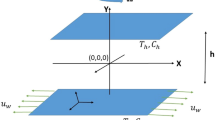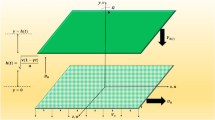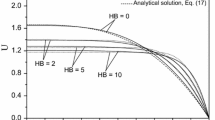Abstract
In laminar flow, viscous fluids must exert appropriate elastic shear stresses normal to the flow direction. This is a direct consequence of the balance of angular momentum. There is a limit, however, to the maximum elastic shear stress that a fluid can exert. This is the ultimate shear stress, \(\tau _\mathrm{y}\), of the fluid. If this limit is exceeded, laminar flow becomes dynamically incompatible. The ultimate shear stress of a fluid can be determined from experiments on plane Couette flow. For water at \(20\,^{\circ }\hbox {C}\), the data available in the literature indicate a value of \(\tau _\mathrm{y}\) of about \(14.4\times 10^{-3}\, \hbox {Pa}\). This study applies this value to determine the Reynolds numbers at which flowing water reaches its ultimate shear stress in the case of Taylor–Couette flow and circular pipe flow. The Reynolds numbers thus obtained turn out to be reasonably close to those corresponding to the onset of turbulence in the considered flows. This suggests a connection between the limit to laminar flow, on the one hand, and the occurrence of turbulence, on the other.
Similar content being viewed by others
References
Reynolds, O.: An experimental investigation of the circumstances which determine whether the motion of water in parallel channels shall be direct or sinuous and of the law of resistance in parallel channels. Phil. Trans. R. Soc. 174, 935–982 (1883)
Tritton, D.J.: Physical Fluid Dynamics, 2nd edn. OUP, New York (1988)
Tsinober, A.: An Informal Conceptual Introduction to Turbulence, 2nd edn. Springer, New York (2009)
Eames, I., Flor, J.B.: New developments in understanding interfacial processes in turbulent flow. Phil. Trans. R. Soc. A 369, 702–705 (2009)
Paglietti, A.: Thermodynamic Limit to the Existence of Inanimate and Living Systems. Sepco-Acerten, Milano (2014)
Fung, Y.C., Tong, P.: Classical and Computational Solid Mechanics. World Scientific, Singapore (2001)
Apakashev, R.A., Pavlov, V.V.: Determination of the shear strength and modulus of water at low flow velocities. Fluid Dyn. 32, 1–4 (1997)
Badmaev, B.B., Bal’zhinov, S.A., Damdinov, B.B., Dembelova, T.S.: Low-frequency shear elasticity of liquids. Phys. Acoust. 56, 640–643 (2010)
Greenwood, M.S., Bamberger, J.A.: Measurement of viscosity and shear wave velocity of a liquid or slurry for on-line process control. Ultrasonics 39, 623–630 (2002)
Herzfeld, K.F., Litovitz, T.A.: Absorption and Dispersion of Ultrasonic Wave. Academic Press, New York (1959)
Joseph, D.D., Riccius, O., Arney, M.: Shear-wave speeds and elastic moduli for different liquids. Part 2. Experiments. J. Fluid Mech. 171, 309–338 (1986)
Korenchenko, A.E., Beskachko, V.P.: Determining the shear modulus of water in experiments with a floating disk. J. Appl. Mech. Tech. Phys. 49, 80–83 (2008)
Dudko, V.V., Yushkanov, A.A., Yalamov, Y.: Generation of shear waves in gas by a vibrating surface. High Temp. 47, 243–249 (2009)
Cercignani, C., Majorana, A.: Analysis of thermal and shear waves according to BKG kinetic model. J. Appl. Math. Phys. ( ZAMP) 36, 699–711 (1985)
Karabacak, D.M., Yakhot, V., Ekinci, K.L.: High-frequency nanofluidics: an experimental study using nanomechanical resonators. Phys. Rev. Lett. 98(25), 254505 (2007)
Tillmark, N., Alfredson, P.H.: Experiments in plane Couette flow. J. Fluid Mech. 235, 89–102 (1992)
Batchelor, G.K.: An Introduction to Fluid Dynamics. CUP, Cambridge (2000)
Acheson, D.J.: Elementary Fluid Dynamics. OUP, New York (1990)
Sokolnikoff, I.S.: Mathematical Theory of Elasticity, 2nd edn. McGraw-Hill, New York (1956)
Malvern, E.M.: Introduction to the Mechanics of a Continuous Medium. Prentice-Hall, Englewood Cliffs, NJ (1969)
Feynman, R.P., Leighton, R.B., Sands, M.: The Feynman Lectures on Physics, 2nd edn. Addison-Wesley, Reading, MA (1975)
Sinha, M., Kevrekidis, I.G., Smits, A.J.: Experimental study of a Neimark–Sacker bifurcation in axially forced Taylor–Couette flow. J. Fluid Mech. 558, 1–32 (2006)
White, F.M.: Fluid Mechanics, 7th edn. McGraw-Hill, New York (2011)
Pfenniger, W.: Transition in the inlet length of tubes at high Reynolds numbers. In: Lachman, G. (ed.) Boundary Layer and Flow Control, pp. 970–980. Pergamon, New York (1961)
Peng, X.F., Peterson, G.P., Wang, B.X.: Heat transfer characteristics of water flowing through microchannels. Exper. Heat Transf. 7, 265–283 (1994)
Eckhardt, B.: Introduction: Turbulence transition in pipe flow: 125th anniversary of the publication of Reynolds’ paper. Phil. Trans. R. Soc. A 367, 449–455 (2009)
Durst, F., Haddad, K., Ertunç, Ö.: Influence of test-rigs on the laminar-to-turbulent transition of pipe flows. In: Eckhardt, B. (ed.) Advances in Turbulence XII. Springer Proceedings in Physics, 135th edn, pp. 131–134. Springer, Berlin (2009)
Author information
Authors and Affiliations
Corresponding author
Additional information
Communicated by Andreas Öchsner.
Rights and permissions
About this article
Cite this article
Paglietti, A. The role of angular momentum in the laminar motion of viscous fluids. Continuum Mech. Thermodyn. 29, 611–623 (2017). https://doi.org/10.1007/s00161-016-0549-3
Received:
Accepted:
Published:
Issue Date:
DOI: https://doi.org/10.1007/s00161-016-0549-3




